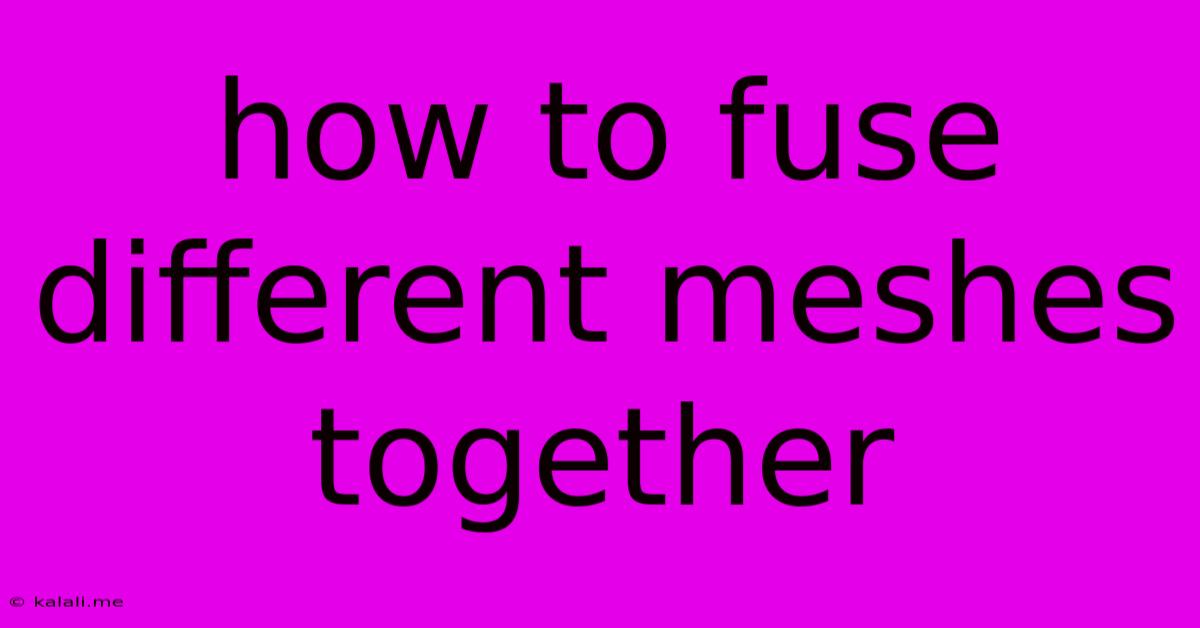How To Fuse Different Meshes Together
Kalali
May 29, 2025 · 3 min read

Table of Contents
How to Fuse Different Meshes Together: A Comprehensive Guide for 3D Modeling
This article will guide you through the process of fusing different meshes together in 3D modeling, a crucial technique for creating seamless and efficient 3D models. Whether you're working with characters, environments, or props, understanding mesh fusion is essential for optimizing your workflow and achieving professional-looking results. We'll explore various methods and software options, catering to both beginners and experienced modelers. This guide covers key concepts like topology, normal orientation, and cleaning up your meshes before and after fusion.
Why Fuse Meshes?
Fusing meshes is more than just combining objects; it's about optimizing your model. Multiple separate meshes can lead to performance issues, especially in complex scenes. Fusing them into a single mesh streamlines rendering, animation, and overall file size, leading to smoother workflows and improved efficiency. This is particularly important for games, animations, and real-time rendering applications where performance is paramount. Additionally, fused meshes allow for more consistent texturing and shading across the combined geometry.
Methods for Fusing Meshes
The specific methods for mesh fusion vary slightly depending on the 3D modeling software you're using, but the underlying principles remain the same. Here are some common approaches:
1. Boolean Operations: Most 3D modeling software offers Boolean operations (Union, Difference, Intersection). The Union operation is the one you need for mesh fusion. It combines two or more meshes into a single, unified mesh. This is generally the most straightforward approach.
- Advantages: Relatively simple to use, widely supported across software.
- Disadvantages: Can be computationally expensive for very complex meshes, may require careful mesh preparation (manifold geometry, clean topology).
2. Using the "Merge" or "Join" Function: Many programs have a dedicated "Merge" or "Join" function specifically designed to combine meshes. This often involves selecting the meshes you want to fuse and then applying the merge command.
- Advantages: Often faster than Boolean operations for simpler meshes.
- Disadvantages: May not always handle complex topology as well as Boolean operations, potentially leading to issues with normals.
3. Manual Vertex Welding/Edge Stitching: For precise control, especially when dealing with complex intersections or requiring highly specific fusion points, manual welding or stitching is an option. This involves selecting vertices or edges from adjoining meshes and then merging them manually.
- Advantages: Maximum control over the fusion process, perfect for intricate details.
- Disadvantages: Time-consuming and requires a strong understanding of mesh topology.
Preparing Your Meshes for Fusion
Successful mesh fusion requires some preparation to avoid unexpected results. Here are some key steps:
- Clean Topology: Ensure your meshes have clean topology – no overlapping faces, non-manifold geometry, or excessively long or skinny polygons. This is crucial for preventing issues after fusion.
- Consistent Normal Orientation: Verify that the normals (the direction a polygon faces) are consistently oriented on both meshes. Incorrect normals can lead to shading problems after fusion.
- Matching Units: Make sure your meshes use the same units (meters, centimeters, etc.). Inconsistencies can lead to unexpected scaling issues after fusion.
Post-Fusion Cleanup
After fusing your meshes, it's often necessary to perform some cleanup:
- Remove Duplicate Vertices: The fusion process might leave behind duplicate vertices. Removing these helps optimize the mesh and improve performance.
- Remeshing: Depending on the complexity of the original meshes and the fusion method used, remeshing might be beneficial to smooth out any irregularities and improve overall mesh quality.
- Normal Recalculation: Recalculating the normals after fusion helps ensure proper shading.
Software-Specific Examples
While the general principles remain consistent, the exact process will vary depending on your 3D software. Consult your software's documentation for specific instructions on mesh fusion. Common programs like Blender, Maya, 3ds Max, and ZBrush all provide tools for mesh fusion.
By following these guidelines and adapting them to your chosen software, you can efficiently and effectively fuse meshes to create cleaner, more optimized, and visually appealing 3D models. Remember to prioritize proper mesh preparation for the best results.
Latest Posts
Latest Posts
-
Why The Fridge Is Not Cold But The Freezer Is
May 31, 2025
-
How Much Is Juice Of One Orange
May 31, 2025
-
How To Uninstall Arc Menu In Terminal
May 31, 2025
-
Can I Paint Pressure Treated Wood
May 31, 2025
-
How Many Gallons Does A Dishwasher Use
May 31, 2025
Related Post
Thank you for visiting our website which covers about How To Fuse Different Meshes Together . We hope the information provided has been useful to you. Feel free to contact us if you have any questions or need further assistance. See you next time and don't miss to bookmark.